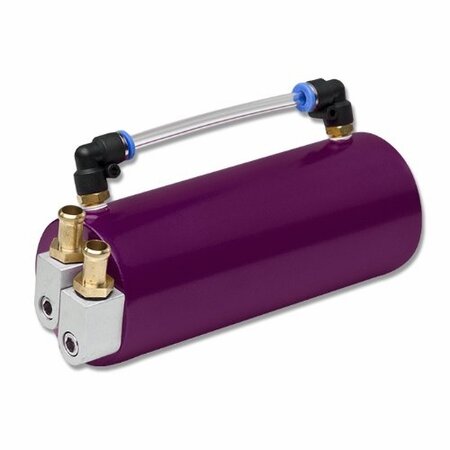Doug D.
"Tin Man"
Anybody here ever use an oil catch tank on a veedub motor? Typically, they're used on high compression/high performance engines to catch and separate oil mist from crank case gasses before they are recirculated back to the intake through the PCV circuit.
My engine has an aftermarket oil filler with a port for routing a tube from same back to the intake, in my case, the bottom of the air cleaner. My engine has always puked a little oil out of this port no matter which way I turn it. I used to run a tube to the intake, but got tired of cleaning excess oil out of my air cleaner and carb. I replaced the tube with a simple breather filter to keep the carb clean, but now I have the mess of an oil drip out of the breather.
Compression, blow-by and leak down tests all come back well within specs, so barring any additional information, I've tentatively ruled out an engine problem as the cause of the drip. I was once told by a "buggy guy" that this drip is normal and most folks just run a hose from the port and let the oil hit the ground. I suppose that's ok, if you like scrubbing the garage floor every other weekend.
So back to these tanks... I've found a ton of variations on the net, but they all basically look like this;

There's an "in" port and an "out" port, and the better ones have a sight gauge for monitoring oil level in the tank, removable end caps for cleaning, and are equipped with a down tube on the "in" side to direct the gasses and oil mist to the bottom of the device, and a baffle to separate the gasses and mist. PCV gasses and atomized oil pass through the tank. The separated oil collects in the bottom of the tank and the gasses are routed back to the intake as previously stated.
While I see these tanks, in my case anyway, as a band-aid solution for what I pray isn't a bigger problem, they present a solution for an annoying mess. They range in price from less than $40 to a couple hundred, depending on how much you want to spend on a "name brand".
I've found a couple cheaper units on the very low end with end caps that would allow the user to add their own down tube and baffle.
Any thoughts on the use of such a device, or as to other causes of the drip?
As always, thanks in advance and ride safe!
Oh, and here's a link on the subject that I thought was interesting;
http://oilcatchcan.com/
My engine has an aftermarket oil filler with a port for routing a tube from same back to the intake, in my case, the bottom of the air cleaner. My engine has always puked a little oil out of this port no matter which way I turn it. I used to run a tube to the intake, but got tired of cleaning excess oil out of my air cleaner and carb. I replaced the tube with a simple breather filter to keep the carb clean, but now I have the mess of an oil drip out of the breather.
Compression, blow-by and leak down tests all come back well within specs, so barring any additional information, I've tentatively ruled out an engine problem as the cause of the drip. I was once told by a "buggy guy" that this drip is normal and most folks just run a hose from the port and let the oil hit the ground. I suppose that's ok, if you like scrubbing the garage floor every other weekend.
So back to these tanks... I've found a ton of variations on the net, but they all basically look like this;

There's an "in" port and an "out" port, and the better ones have a sight gauge for monitoring oil level in the tank, removable end caps for cleaning, and are equipped with a down tube on the "in" side to direct the gasses and oil mist to the bottom of the device, and a baffle to separate the gasses and mist. PCV gasses and atomized oil pass through the tank. The separated oil collects in the bottom of the tank and the gasses are routed back to the intake as previously stated.
While I see these tanks, in my case anyway, as a band-aid solution for what I pray isn't a bigger problem, they present a solution for an annoying mess. They range in price from less than $40 to a couple hundred, depending on how much you want to spend on a "name brand".
I've found a couple cheaper units on the very low end with end caps that would allow the user to add their own down tube and baffle.
Any thoughts on the use of such a device, or as to other causes of the drip?
As always, thanks in advance and ride safe!
Oh, and here's a link on the subject that I thought was interesting;
http://oilcatchcan.com/






